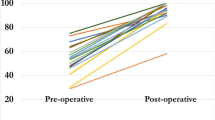Abstract
Purpose
Severe Blount’s disease results in a multiplanar deformity of the lower limb. The mechanical axis is disrupted, there is a rotational deformity, and also shortening of the limb. A depression of the medial tibial plateau causes joint incongruity and instability. The purpose of this study is to review the results of treatment addressing all the aspects of the deformity.
Methods
Four patients were treated for severe Blount’s disease. The index procedure consisted of a medial tibial plateau elevating osteotomy, a lateral tibial and proximal fibular epiphysiodesis, a proximal tibial metaphyseal osteotomy, and the application of the Taylor Spatial Frame programmed for correction of varus, rotation and shortening, and preemptive lengthening to compensate for growth arrest.
Results
Mechanical axis was corrected from a mean 23° (13°–30°) to 0° in three patients and 6° valgus in 1. Tibias were lengthened by 1–4 cm. At follow-up, the mechanical axis was 0° in two patients and 7° varus in two. The overlengthening was diminishing as planned.
Conclusions
The double osteotomy and Taylor Frame correction was found to be accurate, safe, and effective for multiplanar deformity correction in severe Blount’s disease.




Similar content being viewed by others

References
Beck CL, Burke SW, Roberts JM, Johnston CE (1987) Physeal bridge resection in infantile Blount disease. J Pediatr Orthop 7:161–163
Martin SD, Moran MC, Martin TL, Burke SW (1994) Proximal tibial osteotomy with compression plate fixation for tibia vara. J Pediatr Orthop 14:619–622
Sasaki T, Tomonori Y, Monji J, Yasuda K, Kanno Y (1986) Transepiphyseal plate osteotomy for severe tibia vara in children: follow-up study of four cases. J Pediatr Orthop 6:61–65
Gregosiewicz A, Wosko I, Kandzierski G, Drabik Z (1989) Double-elevating osteotomy of tibiae in the treatment of severe cases of Blount’s disease. J Pediatr Orthop 9:178–181
Rab GT (1988) Oblique tibial osteotomy for Blount’s disease. J Pediatr Orthop 8:715–720
Langenskiold A (1981) Tibia vara: osteochondrosis deformans tibiae. Blount’s disease. Clin Orthop Relat Res 158:77–82
Schoenecker PL, Johnston R, Rich MM, Capelli AM (1992) Elevation of the medial plateau of the tibia in the treatment of Blount disease. J Bone Joint Surg 74-A:351–358
Jones S, Hosalkar HS, Hill RA, Hartley J (2003) Relapsed infantile Blount’s disease treated by hemiplateau elevation using the Ilizarov frame. J Bone Joint Surg 85-B:565–571. doi:10.1302/0301-620X.85B4.13602
Accadbled F, Laville JM, Harper L (2003) One step treatment for evolved Blount’s disease. J Pediatr Orthop 23:747–752. doi:10.1097/00004694-200311000-00012
Hefny H, Shalaby H, El-kawy S, Thakeb M, Elmoatasem E (2006) A new double elevating osteotomy in management of severe neglected infantile tibia vara using the Ilizarov technique. J Pediatr Orthop 26:233–237
Janoyer M, Jabbari H, Rouvillain JL, Sommier J, Py G, Catonne Y et al (2007) Infantile Blount’s disease treated by hemiplateau elevation and epiphyseal distraction using a specific external fixation: a preliminary report. J Pediatr Orthop B 16:273–280
Feldman DS, Madan SS, Koval KJ, van Bosse HJ, Bazzi J, Lehman WB (2003) Correction of tibia vara with six-axis deformity analysis and the Taylor Spatial Frame. J Pediatr Orthop 23(3):387–391. doi:10.1097/00004694-200305000-00022
Feldman DS, Madan SS, Ruchelsman DE, Sala DA, Lehman WB (2006) Accuracy of correction of tibia vara: acute versus gradual correction. J Pediatr Orthop 26:794–798
Slawski DP, Schoenecker PL, Rich MM (1994) Peroneal nerve injury as a complication of pediatric tibial osteotomies. J Pediatr Orthop 14(2):166–172
Pinkowski JL, Weiner DS (1995) Complications in proximal tibial osteotomies in children with presentation of technique. J Pediatr Orthop 15(3):307–312
Payman KR, Patenall V, Borden P, Green T, Otsuka NY (2002) Complications of tibial osteotomies in children with comorbidities. J Pediatr Orthop 22(5):642–644. doi:10.1097/00004694-200209000-00014
van Huyssteen AL, Hastings CJ, Olesak M, Hoffman EB (2005) Double-elevating osteotomy for late-presenting infantile Nlount’s disease: the importance of concomitant lateral epiphysiodesis. J Bone Joint Surg 87-B:710–715
Acknowledgments
No financial support was received for this study.
Author information
Authors and Affiliations
Corresponding author
About this article
Cite this article
Bar-On, E., Weigl, D.M., Becker, T. et al. Treatment of severe early onset Blount’s disease by an intra-articular and a metaphyseal osteotomy using the Taylor Spatial Frame. J Child Orthop 2, 457–461 (2008). https://doi.org/10.1007/s11832-008-0140-y
Received:
Accepted:
Published:
Issue Date:
DOI: https://doi.org/10.1007/s11832-008-0140-y



